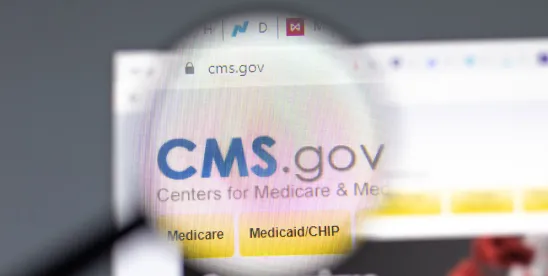Key Takeaways
- CMS is expected to issue the 2026 final rate notice for Medicare Advantage (MA) and Part D plans by April 7, 2025.
- The January 2025 advance notice proposed policies that would increase payments to MA plans by 2.23% on average; accounting for expected changes in coding increases CMS’ estimate to 4.33%. The increase is driven largely by a projected 5.93% growth in benchmarks, continued phase-in of a new risk model, and adjustments to risk scores.
- Plans have advocated with CMS to increase cost growth projections and minimize the impact of payment and risk score adjustments, with the goal of improving on the 2.23% payment increase.
- An expected MA and Part D final rule could also affect how plans and other stakeholders approach the 2026 payment year.
Why This Matters
The Centers for Medicare & Medicaid Services (CMS) is expected to finalize payment rates and policies for the 2026 Medicare Advantage (MA) and Part D programs in early April 2025. The final rate notice kicks off the sprint to submit 2026 plan bids to CMS by the June 2, 2025, deadline.
The final payment policies determine how plans approach bidding, including:
- Whether and by how much they can provide core Medicare benefits below the benchmarks CMS sets.
- How many rebate dollars they must spend on supplemental benefits that enrollees value.
- How much they must spend to offer Part D benefits for the majority of plans that combine medical and prescription drug coverage.
A growing number of physicians are also taking note of the rate setting process. Physicians who participate in shared risk and other value-based payment models with MA plans stand to gain or lose revenue depending on the final payment rates and policies. Providers considering whether to participate in MA networks may look to the final rate notice to evaluate a program’s potential growth in the coming year, because rate increases typically lead to more generous benefits and drive enrollment.
The following key elements of the rate notice will determine the final payment update for 2026.
Growth Rate
The growth rate is CMS’s estimate of how much the cost of providing care to enrollees will change in 2026. It forms the basis for benchmark payments to plans and is primarily based on utilization trends among Medicare beneficiaries in the “traditional” or fee-for-service (FFS) program. MA plans benefit when the growth rate is high.
The advance notice estimated the 2026 growth rate at 5.93%, which is an increase over recent years. MA plans noted that this estimate relied on FFS data only through early 2024, however, and argued that using more recent data would suggest even higher utilization. Plans have urged CMS to do so for the final notice.
The advance notice also proposed “technical” adjustments to the way CMS calculates FFS utilization and costs. These adjustments would effectively lower the growth rate, and plans have urged CMS to slow or halt the changes’ implementation to limit that impact.
Stakeholders should keep in mind that the growth rate announced in the final rate notice is a national average. Benchmark payments are set at the county level, so a plan’s payments will rise or fall based on where it offers coverage and enrolls members. Payments are also affected by a plan’s Star rating and its enrollees’ health status. Plans will rely on detailed county-level data released in conjunction with the final rate notice to determine exactly how their payments will change for 2026.
Risk Model
While the growth rate determines how much the benchmark payment in a county will change for 2026, the risk model is also an important piece of payment. In 2024, CMS began phasing in an updated risk model for MA that was intended to address concerns about coding intensity that led to higher risk-adjusted payments. The transition to the new risk model is scheduled to conclude in 2026, but some plans have urged CMS to freeze the transition at the current stage or reinstate the old risk model. Even if the Trump administration is sympathetic to this request, it likely would not have enough time to reinstate the old risk model for the 2026 bid cycle. Other stakeholders have urged CMS to finish the phase-in as scheduled, arguing that the new model imposes necessary curbs on the growing gap between FFS and MA risk scores.
A separate risk model adjusts Part D payments. The Inflation Reduction Act changed Part D benefit design by shifting a greater share of risk from the government to plans. As a result, the Part D risk model has taken on added importance for plans. Almost all MA enrollees choose plans that include Part D benefits, so changes to the Part D risk model are an important part of the MA payment calculation. CMS adjusted the model in 2025 and proposed more updates for 2026 to keep up with drug prices and utilization trends. Stakeholders have generally expressed support for the proposed updates, and CMS will likely finalize them as proposed.
Normalization Factor
The normalization factor is a highly technical adjustment CMS makes to risk scores and payments to account for changes in the FFS population’s underlying risk. It is one of the few levers CMS has, besides the growth rate, to dial MA payments up or down in a given year. How CMS calculates the normalization factor can have a big impact on payment. Because the healthcare disruptions of the COVID-19 pandemic made it difficult to identify risk trends, CMS has varied its calculation approach in recent years. For 2026, CMS proposed to use the same calculation method as in 2025, which would result in substantial cuts to MA risk scores and payments. Plans have urged CMS to adopt a different calculation approach that would soften the payment impact of the normalization adjustment.
In 2025 CMS changed the way Part D normalization is applied by creating separate factors for plans that combine MA and Part D benefits (MA-PDs) and plans that offer Part D benefits only (PDPs). CMS’s rationale was that Part D risk scores have increased much faster for MA-PDs than for PDPs. CMS proposed to continue this method in 2026, which could mean large reductions in Part D risk scores and payments to MA-PDs. Plans have argued that lower Part D risk-adjusted payments will lead to higher Part D premiums, which they must “buy down” with rebate dollars in order to offer plans that include both medical and drug coverage with no monthly premium. About 60% of MA enrollees enrolled in a $0 premium plan in 2025.
Stars Rating System
High scores in the Stars Rating System trigger bonus payments for MA plans and are an important marketing tool. The 2026 advance notice discussed several measure updates and work on potential changes like simplifying the measures and methods used to calculate ratings but most Stars changes come through rulemaking, not the rate notice process. While stakeholders should not expect to see any of these changes formalized in the final rate notice, they offer a preview of rulemaking to come.
Upcoming Final Rule
The final rate notice is not CMS’s only opportunity to make changes to the MA and Part D programs for 2026. In late 2024, CMS released a proposed rule for MA and Part D with provisions that would take effect in 2026. The final rule is now under review at the Office of Management and Budget, so CMS potentially could finalize some or all of those provisions in time for the 2026 bid cycle. One key proposal would allow Part D plans to cover anti-obesity medications such as Wegovy and Zepbound. While plans and other stakeholders have raised serious concerns about this proposal and urged CMS not to finalize it, many beneficiaries have expressed support.
The Bottom Line and What to Expect
When releasing the advance rate notice, CMS estimated MA payment rates would rise by 2.23% for 2026, on average. After factoring in expected trends in diagnosis coding, the agency projected an average MA payment rate increase of 4.33%. The advance rate notice was released under the Biden administration, so changes in the final rate notice might illuminate the Trump administration’s approach to MA. A bottom-line increase that improves on the 2.23% in the advance notice might bode well for plans and their physician partners. Anything less than 2.23% might signal rough seas ahead for the MA program.






 />i
/>i

